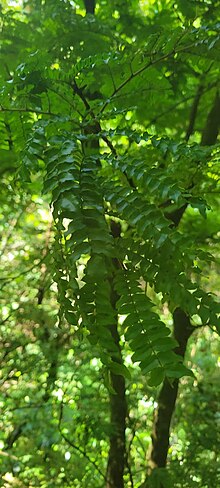| Cojoba costaricensis | |
|---|---|

| |
| Conservation status | |
 Near Threatened (IUCN 3.1) | |
| Scientific classification | |
| Kingdom: | Plantae |
| Clade: | Tracheophytes |
| Clade: | Angiosperms |
| Clade: | Eudicots |
| Clade: | Rosids |
| Order: | Fabales |
| Family: | Fabaceae |
| Subfamily: | Caesalpinioideae |
| Clade: | Mimosoid clade |
| Genus: | Cojoba |
| Species: | C. costaricensis |
| Binomial name | |
| Cojoba costaricensis Britton & Rose | |
| Synonyms | |
| |
Cojoba costaricensis, commonly known as angel's hair, lorito, or cabello de angel, is a species of plant in the family Fabaceae that is endemic to Costa Rica and Panama.
Distribution and habitat
C. costaricensis is native to montane areas of Costa Rica and Panama, where it grows in humid cloud and oak forests at elevations of 1,150–2,000 m (3,770–6,560 ft) above sea level.
Description
C. costaricensis is a rounded tree growing to 15 m (49 ft) tall. The twigs, petioles, rachises, and peduncles are densely covered in fine brown hairs. The leaves are bipinnate with 4-8 pairs of pinnae, each pinna bearing 7-14 pairs of leaflets. Small nectar glands can be found between the pinnae. The leaflets are oblong-lanceolate with a rounded base and somewhat pointed tip, each measuring 1.5–2.5 cm (0.59–0.98 in) long. The white, brushlike flowers are borne on a 3–6 cm (1.2–2.4 in) peduncle. The fruits are long, red pods growing up to 15 cm (5.9 in) long, twisting as they mature to reveal shiny black seeds.
Ecology
C. costaricensis flowers from January to November, with the flowers pollinated by moths.
Conservation status
C. costaricensis is listed as near threatened by the International Union for the Conservation of Nature under criteria B1b(iii). It is reported to be very common in Costa Rica and occurs in many protected areas (including Alberto Manuel Brenes Biological Reserve, La Amistad International Park, Braulio Carrillo National Park, Grecia Forest Reserve, and Guanacaste National Park), however, almost all habitat suitable for this species located outside of protected areas has been deforested or heavily disturbed. The wood of C. costaricensis is also harvested for timber.
References
- ^ Rodríguez, A.; Monro, A.; Chacón, O.; Solano-Rojas, D.; Santamaría-Aguilar, D.; Zamora, N.; Correa, M.; González, F. (2021). "Cojoba costaricensis". IUCN Red List of Threatened Species. 2021: e.T152001402A152001404. doi:10.2305/IUCN.UK.2021-2.RLTS.T152001402A152001404.en. Retrieved 14 September 2024.
- "Cojoba costaricensis Britton & Rose". Plants of the World Online. Royal Botanic Gardens, Kew. Retrieved 14 September 2024.
- ^ Zuchowski, Willow (2007). Tropical Plants of Costa Rica: A Guide to Native and Exotic Flora. Ithaca: Cornell University Press. p. 292. ISBN 9780801445880.
- Britton, Nathaniel Lord; Rose, Joseph Nelson (1928). (Rosales) Mimosaceae. North American Flora. Vol. 23. New York: New York Botanical Garden. p. 31 – via Biodiversity Heritage Library.
| Taxon identifiers | |
|---|---|
| Cojoba costaricensis | |
This Mimosoideae-related article is a stub. You can help Misplaced Pages by expanding it. |